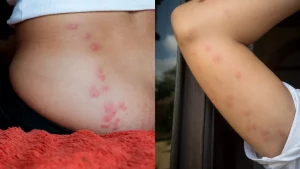
Bed Bug Bites – Understanding, Identifying, and Preventing Infestations
Bed bug infestations have become a pervasive issue globally, affecting households, hotels, and public spaces. The prevalence of bed bug infestations is a significant concern due to the health and well-being implications associated with bed bug bites. In this comprehensive guide, we will delve into various aspects of bed bug bites, ranging from understanding bed bugs themselves to prevention strategies and legal considerations.
The Prevalence of Bed Bug Infestations
Bed bugs have made a notable resurgence in recent decades, with a significant increase in infestations reported worldwide. Factors such as increased travel, pesticide resistance, and lack of awareness have contributed to this rise in bed bug prevalence.
The Impact of Bed Bug Bites on Health and Well-being
Bed bug bites can cause physical discomfort, allergic reactions, and psychological distress. The effects of bed bug bites extend beyond the skin, affecting mental health and overall well-being. Understanding the consequences of bed bug bites is vital for effective prevention and management.
[ez-toc]
Understanding Bed Bugs
The pictures below show a bed bud during a blood meal as it gradually fills with blood
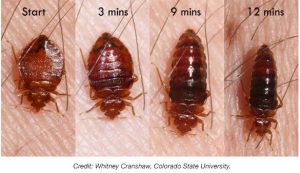
Physical Characteristics of Bed Bugs
Bed bugs are small, wingless, parasitic insects that feed on the blood of humans and other animals. They are about the size of an apple seed, with a flat, oval-shaped body. Unfed bed bugs are reddish-brown in color, but they darken to a mahogany brown after feeding.
Here is a summary of the physical characteristics of bed bugs:
- Size: Adult bed bugs are about 4-5 mm long and 3 mm wide.
- Shape: Bed bugs have a flat, oval-shaped body.
- Color: Unfed bed bugs are reddish-brown in color. After feeding, they turn a mahogany brown.
- Mouthparts: Bed bugs have a piercing-sucking mouthpart that they use to feed on blood.
- Antennae: Bed bugs have four-segmented antennae.
- Eyes: Bed bugs have two compound eyes.
- Legs: Bed bugs have six legs.
- Wings: Bed bugs do not have wings.
Bed bugs can be difficult to see, especially when they are unfed. They are also nocturnal, meaning they are most active at night. Bed bugs often hide in cracks and crevices in mattresses, box springs, headboards, and bed frames. They can also be found in other furniture, such as sofas, chairs, and carpets.
Bed Bug Life Cycle and Reproduction
The bed bug life cycle comprises eggs, nymphs (five instars), and adults. Bed bugs undergo incomplete metamorphosis, requiring a blood meal to molt and progress through each stage.
Common Hiding Spots and Habitats
Bed bugs often hide in cracks, crevices, seams, and folds of mattresses, furniture, and other hiding spots near their hosts. Understanding their hiding places is crucial for effective detection and elimination.
Identifying Bed Bug Bites
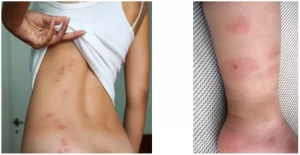
Characteristics of Bed Bug Bites
Bed bug bites typically manifest as small, red, itchy welts on the skin. They are often arranged in a linear or clustered pattern.
Distinguishing Bed Bug Bites from Other Insect Bites
Distinguishing bed bug bites from other insect bites, such as mosquito or flea bites, is essential for accurate identification and appropriate treatment.
Bed bug bites can be easily confused with other insect bites, such as mosquito bites. However, there are some key differences that can help you distinguish between the two.
Here is a table that summarizes the key differences between bed bug bites and other insect bites:
| Characteristic | Bed bug bites | Other insect bites |
|---|---|---|
| Appearance | Bed bug bites usually appear in clusters or lines, and they are often found on exposed areas of skin, such as the neck, face, arms, and legs. Bed bug bites can be red, itchy, and raised, and they may have a central red dot. | Other insect bites, such as mosquito bites, can appear anywhere on the body. They are often isolated and randomly distributed. Mosquito bites are typically red and itchy, and they may have a raised bump in the center. |
| Reaction time | People typically do not feel bed bug bites until hours or days after they are bitten. This is because bed bugs inject an anesthetic when they bite. Mosquito bites, on the other hand, are usually felt immediately. | |
| Bite pattern | Bed bug bites often appear in a cluster or line. This is because bed bugs tend to bite multiple times in one area. Mosquito bites are typically isolated and random. | |
| Location | Bed bug bites are often found on exposed areas of skin, such as the neck, face, arms, and legs. Mosquito bites can appear anywhere on the body. |
Reaction Time and Symptoms After Being Bitten
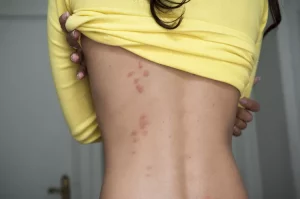
The reaction time and symptoms after being bitten by a bed bug vary from person to person. Some people may have no reaction at all, while others may experience severe itching, swelling, and other symptoms.
Symptoms of bed bug bites may appear within minutes or take several days to manifest. It is essential to monitor the reaction time and any accompanying symptoms for proper assessment.
Most people do not feel bed bug bites until hours or days after they are bitten. This is because bed bugs inject an anesthetic when they bite. In some cases, people may not notice they have been bitten for weeks or even months.
Symptoms
The most common symptoms of bed bug bites are:
- Itching
- Redness
- Swelling
- Blisters
Bed bug bites often appear in clusters or lines, and they are often found on exposed areas of skin, such as the neck, face, arms, and legs. Bed bug bites can also be found on other parts of the body, such as the back, chest, and abdomen.
In some cases, bed bug bites can cause more serious symptoms, such as:
- Infection
- Allergic reaction
- Insomnia
- Anxiety
If you experience any of these symptoms after being bitten by a bed bug, it is important to see a doctor.
Health Implications of Bed Bug Bites
Allergic Reactions
Bed bug bites can trigger allergic reactions in some individuals, leading to severe itching, hives, and even anaphylaxis in rare cases. Prompt medical attention is necessary for severe allergic reactions.
Psychological Effects and Mental Health Impact
Dealing with a bed bug infestation and the resulting bites can cause anxiety, stress, and sleep disturbances. The psychological impact can be significant and may require professional intervention and support.
Preventing Bed Bug
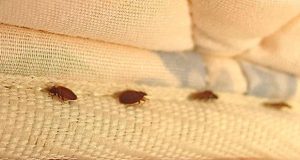
Tips for Preventing Bed Bug Infestations at Home
Practical measures such as regular cleaning, decluttering, and sealing cracks can significantly reduce the risk of a bed bug infestation at home. Here are some tips for preventing bed bug infestations at home:
- Inspect your home regularly – Pay attention to your mattress, box spring, bed frame, and other furniture for signs of bed bugs, such as live bed bugs, empty egg casings, or fecal matter.
- Vacuum regularly – Be sure to vacuum under the bed, around the headboard, and in other places where bed bugs may hide.
- Wash your bedding in hot water and dry it on high heat. This will kill any bed bugs or their eggs that may be present.
- Avoid bringing secondhand furniture into your home. If you do bring secondhand furniture into your home, be sure to inspect it carefully for signs of bed bugs before bringing it inside.
- Be careful when traveling – Inspect your hotel room for signs of bed bugs before unpacking your belongings. If you find bed bugs in your hotel room, contact the hotel management immediately.
Here are some additional tips:
- Seal any cracks or crevices in your home. This will make it more difficult for bed bugs to enter your home.
- Use bed bug covers on your mattress and box spring. This will prevent bed bugs from hiding inside your mattress and box spring.
- Keep your bedroom clutter-free. Bed bugs like to hide in clutter, so it is important to keep your bedroom as clean and tidy as possible.
If you think you may have a bed bug infestation, it is important to contact a pest control professional immediately. Bed bugs can be difficult to get rid of, so it is best to leave it to the professionals.
Bed Bug Prevention During Travel and Hotel Stays
Travelers should inspect hotel rooms, use protective encasements, and follow precautions to avoid bringing bed bugs home after a trip.
Here are some tips for bed bug prevention during travel and hotel stays:
- Choose your accommodations wisely. Read reviews of hotels and motels before you book your stay. If you see any reviews that mention bed bugs, avoid that establishment.
- Inspect your hotel room immediately upon arrival. Pull back the sheets and look for signs of bed bugs, such as live bed bugs, empty egg casings, or fecal matter. If you see any signs of bed bugs, contact the hotel management immediately.
- Keep your luggage elevated. Place your luggage on a luggage rack or on a hard surface, such as a dresser or chair. Do not place your luggage on the bed.
- Unpack your belongings in the bathroom. Bed bugs are less likely to hide in the bathroom, so this is a good place to unpack your belongings.
- Wash your clothes in hot water and dry them on high heat. This will kill any bed bugs or their eggs that may be present.
- Inspect your luggage again before you leave. Before you pack up your belongings to leave, inspect your luggage again for signs of bed bugs. If you find any bed bugs, contact the hotel management immediately.
Here are some additional tips:
- Bring a flashlight and a credit card. A flashlight can be used to inspect your hotel room for signs of bed bugs in dark areas. A credit card can be used to pry back bedding and furniture to check for bed bugs.
- Use a bed bug cover on your mattress and box spring. Bed bug covers can help to prevent bed bugs from entering your mattress and box spring.
- Keep your luggage closed when not in use. This will help to prevent bed bugs from getting into your luggage.
- Be careful when using public transportation. Bed bugs can hitchhike on rides, so it is important to inspect your belongings after using public transportation.
Recognizing Early Signs of a Potential Bed Bug Problem
Being vigilant for signs of bed bugs, such as bites, blood spots, or molted skins, can help catch an infestation early and prevent it from spreading.
Checking for Bed Bugs
How to Inspect for Bed Bugs in Your Home
Thorough inspections, focusing on common hiding spots and using a flashlight, are crucial for detecting bed bug infestations in your living space.
Tips for Identifying Bed Bug Infestations
Identifying bed bugs involves recognizing signs such as live bugs, eggs, fecal stains, and bite patterns. Knowing what to look for is essential for a successful inspection.
Using Professionals for Thorough Inspections
In cases of suspected infestations or recurrent issues, seeking help from professional pest control experts for a thorough inspection and treatment is recommended.
Stay tuned for the continuation of this informative blog post, where we’ll cover topics like treating bed bug bites, managing infestations, dealing with bed bugs in different settings, and much more. Knowledge is key to preventing and addressing bed bug issues effectively.
Treating Bed Bug Bites
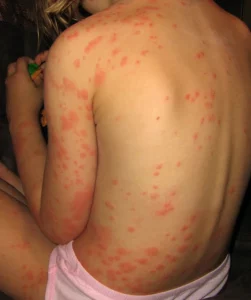
Over-the-Counter Treatments and Remedies
- Antihistamines: These can help reduce itching and allergic reactions caused by bed bug bites.
- Hydrocortisone Cream: Applying this cream to the affected area can help alleviate itching and irritation.
- Calamine Lotion: Calamine can soothe the skin and reduce itching from bed bug bites.
- Oatmeal Baths: Taking a bath with colloidal oatmeal can relieve itchiness and irritation.
- Ice Packs: Applying a cold pack can help reduce swelling and discomfort from bed bug bites.
Home Remedies for Soothing Bed Bug Bites
- Baking Soda Paste: Mixing baking soda with water to create a paste can help relieve itching and inflammation when applied to bites.
- Aloe Vera Gel: Aloe vera has soothing properties that can alleviate itchiness and promote healing of the skin.
- Tea Bags: Applying a used, cooled tea bag to the bite can help reduce itching and inflammation.
- Essential Oils (e.g., Lavender, Peppermint): Diluted essential oils can provide relief from itchiness and may have antibacterial properties.
When to Seek Medical Attention for Severe Reactions
- Allergic Reactions: If you experience severe allergic reactions such as difficulty breathing, chest tightness, or swelling of the face, lips, or tongue, seek immediate medical help.
- Secondary Infections: If a bite becomes infected, causing increased redness, warmth, or discharge, consult a healthcare professional.
Managing Bed Bug Infestations
Professional Pest Control Options
- Chemical Treatments: Pest control professionals may use insecticides specifically designed to eradicate bed bugs. This should be handled by licensed experts.
- Heat Treatments: Professional heat treatments can effectively eliminate bed bugs and their eggs by raising the temperature in the infested area.
DIY Methods for Eliminating Bed Bugs
- Vacuuming: Regularly vacuuming infested areas and disposing of the vacuum bag properly can help manage the population.
- Steam Cleaning: Using a high-temperature steam cleaner on mattresses, furniture, and cracks can kill bed bugs and their eggs.
Bed Bug Bite Prevention for Specific Populations
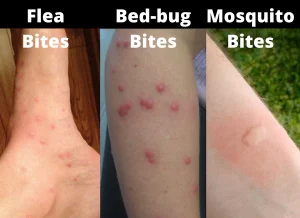
Bed Bug Prevention for Children and Schools
- Education and Awareness: Teach children about bed bugs, how to identify them, and the importance of proper hygiene and cleanliness.
- Regular Checks: Parents and teachers should conduct periodic checks of children’s belongings, especially after school trips or events.
Bed Bug Prevention for the Elderly and Nursing Homes
- Staff Education: Train staff in nursing homes to identify bed bug signs and take appropriate preventive measures.
- Regular Room Inspections: Conduct routine inspections in rooms and communal areas to detect any infestations early.
Bed Bug Prevention for Travelers
- Travel Tips: Use protective encasements for luggage, inspect hotel rooms, and avoid placing luggage on the bed or floor.
- Laundry Precautions: Launder clothing in hot water and inspect luggage thoroughly upon return from a trip.
Natural Remedies for Bed Bug Bites
Aloe Vera and Its Soothing Properties
- Anti-Inflammatory: Aloe vera has anti-inflammatory properties that can reduce redness and swelling from bed bug bites.
- Skin Healing: Applying aloe vera can promote faster healing of the skin.
Tea Tree Oil and Its Antiseptic Qualities
- Antiseptic: Tea tree oil possesses antiseptic properties that may help prevent infection in bed bug bites.
- Anti-Itch: It can also provide relief from itching caused by the bites.
Lavender Oil and Its Calming Effects on Skin
- Soothing Effect: Lavender oil has a calming effect on the skin and can help reduce irritation from bed bug bites.
- Natural Properties: Its natural properties may aid in alleviating itching and redness.
Legal Aspects of Bed Bug Infestations
Tenant and Landlord Rights and Responsibilities
The legal aspects of bed bug infestations vary from state to state. However, there are some general principles that apply.
Landlords and Tenants
Landlords have a duty to provide their tenants with habitable housing. This means that the housing must be free of pests, including bed bugs. If a landlord fails to provide habitable housing, the tenant may be able to withhold rent or sue the landlord for damages.
Tenants also have a responsibility to keep their rental unit clean and free of pests. If a tenant brings bed bugs into the rental unit or fails to take steps to control an existing bed bug infestation, the landlord may be able to evict the tenant.
Hotels and Motels
Hotels and motels have a duty to provide their guests with safe and clean accommodations. This means that the hotel or motel should be free of pests, including bed bugs. If a hotel or motel guest is bitten by bed bugs, the guest may be able to sue the hotel or motel for damages.
Other Establishments
Other establishments, such as businesses, schools, and hospitals, also have a duty to provide their patrons with a safe and pest-free environment. If a person is bitten by bed bugs in one of these establishments, they may be able to sue the establishment for damages.
Reporting Bed Bug Infestations
In some states, it is required to report bed bug infestations to the local health department. This helps health officials to track the spread of bed bugs and to provide assistance to people who have been affected by bed bug infestations.
Promising Technologies To Prevent Bed Bugs
There are a number of promising technologies and innovative approaches to bed bug control that are currently under development. Some of these technologies are still in the early stages of development, but they have the potential to revolutionize the way that bed bugs are controlled.
Here are a few examples:
Heat Treatment: Heat treatment is a promising method for killing bed bugs and their eggs. Heat treatment involves raising the temperature of a room to a level that is lethal to bed bugs. Heat treatment can be effective in killing bed bugs in all stages of development, including eggs.
Insecticidal Coatings: Insecticidal coatings are another promising technology for bed bug control. Insecticidal coatings are applied to surfaces where bed bugs are likely to hide, such as mattresses, box springs, and bed frames. When bed bugs come into contact with the insecticidal coating, they are killed.
Canine Detection: Canine detection is a non-chemical method for detecting bed bugs. Trained dogs can be used to sniff out bed bugs and their eggs in homes and other buildings. Canine detection is a highly effective way to find bed bugs, and it can be used to target treatment to areas where bed bugs are present.
Biopesticides: Biopesticides are pesticides that are derived from natural sources, such as plants or bacteria. Biopesticides are often considered to be safer than traditional synthetic pesticides. There are a number of biopesticides that are currently being developed for bed bug control.
Nanotechnology: Nanotechnology is another promising technology for bed bug control. Nanotechnology can be used to develop new pesticides that are more effective and less harmful to humans and the environment. Nanotechnology can also be used to develop new devices for detecting and killing bed bugs.
These are just a few examples of the promising technologies and innovative approaches that are currently under development for bed bug control. As these technologies continue to develop, they have the potential to make bed bug control more effective and efficient.
In addition to the technologies listed above, there are a number of other innovative approaches to bed bug control that are being developed. For example, some researchers are developing new ways to attract and trap bed bugs. Others are developing new ways to disrupt the bed bug’s life cycle.
As research into bed bug control continues, it is likely that even more promising technologies and innovative approaches will be developed. This is good news for people who are struggling with bed bug infestations.
Conclusion
Bed bug bites are more than just physical discomfort—they can have significant implications for health, well-being, and quality of life. Educating ourselves and others about bed bugs, their bites, prevention, and control measures is crucial in effectively managing infestations and minimizing their impact on individuals and communities. Stay informed, proactive, and vigilant to ensure a bed bug-free environment for a healthier and happier life.
Remember, if you suspect a bed bug infestation, don’t hesitate to seek professional help to address the issue promptly and effectively. Stay bed bug aware and stay bed bug free!